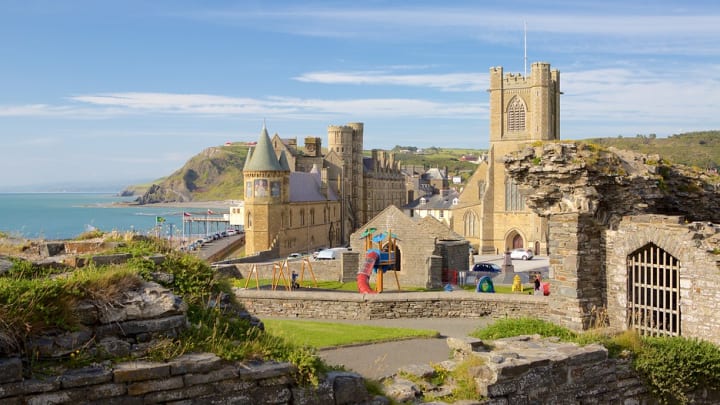A first-time visitor's guide to Wales
A short look at what Wales has to offer

A visitor to the United Kingdom should be encouraged to include Wales on their itinerary, because it is a very special part of the country and different in many ways from England or Scotland.
Visiting Wales for the first time
Anyone who is not a native or a resident of Wales, but has spent an appreciable amount of time there, whether as a student or a holidaymaker or both (like me), will testify that it is impossible to “do” Wales in a single visit, whether that lasts a week, a fortnight or a month.
Wales is relatively small, being about 8,000 square miles in total in a roughly rectangular shape some 160 miles from north to south and 60 miles from east to west. It is therefore not quite as big as New Jersey. However, it is usually best to think of Wales as having three distinct zones, namely North, South and Mid.
This is because of the mountainous territory of most of Wales that makes travel between north and south quite difficult, as most of the road and rail links run from east to west. The visitor is therefore best advised to aim for one of the three regions and to leave the others for another time. Whichever they choose, there will be plenty to see and do.
The first timer should also decide their priorities in terms of what they want to get from their visit. For example, are they most interested in Welsh culture, or its natural scenery, or its castles, or its beaches? Do they want to surf, or to climb mountains, to pony trek, to watch wildlife or travel on its “great little trains”? There is no reason to plump for just one option, but if you have a particular aim in mind, it might not be so easy to plan your visit in a way that incorporates certain others.
For example, Wales is noted for several heritage rail lines that were originally built to transport slate and other goods from the quarries to the coast. These are to be found in Mid and North Wales, and a certain degree of planning would be needed to fit them all into a short break. If the visitor is also interested in the cultural delights of Cardiff, with its first-rate venues for music, opera and theatre, then combining the two interests would be difficult.
It is impossible, in a short article, to describe all that Wales has to offer, so a short breakdown of the three main regions will have to suffice.
South Wales
This is where the majority of Wales’s population lives, particularly in the only two Welsh cities of any size, namely Cardiff and Swansea. The wealth of Wales in the 19th and 20th centuries came from coal-mining and steel, and it was in south-east Wales that these industries were based, although there is little sign of them now.

For the tourist, Cardiff has far more to offer than Swansea, especially since the development of Cardiff Bay that has taken place in recent years. Cardiff, the chief city of Wales, was always an attractive city, with its castle and the civic centre and university buildings around Cathays Park, but the waterside developments, including the new Welsh Assembly building, are generally agreed as being particularly impressive. The tourist could make Cardiff their sole destination with no trouble at all.
However, South Wales has much more to offer, including the magnificent coastal scenery of the Gower peninsular and Pembrokeshire, and the brooding mountainous territory of the Brecon Beacons and Black Mountain. Walkers are well served, whether the choice is hills or coast paths, as are families who seek safe beaches and rock pools.

Mid Wales
The heart of Wales is a land of lakes, forests, deep valleys and windswept moorlands. This is wild country with only a few villages and not many roads. It is therefore a region that will suit people who want to get away from it all, but they will also have to be largely self-reliant.
The chief town of mid Wales is Aberystwyth on the coast, home to the oldest university in Wales and the National Library. It is also well used to catering for tourists, with many small hotels and guest houses. The railway line from Shrewsbury (in England) ends here, as does the steam-powered narrow-gauge Vale of Rheidol line.

is at the mid-point of Cardigan Bay, on which can be found many unspoilt and lonely beaches. Whether one goes inland or stays on the coast, this is excellent territory for wildlife enthusiasts, particularly birdwatchers.
North Wales
The region is dominated by Snowdonia, the mountainous area centred on Snowdon, the highest mountain in Wales. A mountain railway can take you to the summit, or there are a number of well-marked paths that are very popular in summer. The area is something of a tourist trap, so visitors would be well advised to explore other parts of the region if they do not wish to be where everyone else is.

Also popular are the large and well-preserved medieval castles of Harlech, Caernarvon and Conwy. These are reminders of Wales’s history and its eventual domination by England in the 14th century. Children love exploring castles, and North Wales has some fine examples.

The coast of North Wales, eastward from Llandudno, is popular with tourists from the cities of north-west England, so visitors might prefer to head further west, to the Lleyn peninsular and Ynys Mon (Anglesey). It is not difficult to get away from the crowds when one wants to.
Culture in Wales
The first-time visitor should make every effort to absorb some of the culture of Wales, which has a tradition of choral singing that goes back for centuries. If you can attend a concert given by a Welsh male-voice choir it will be an unforgettable experience. Even better is an “eisteddfod” (Welsh for “sitting”) which is a festival of music, dance and literature. The 8-day National Eisteddfod is an annual festival held in early August, but local eisteddfodau are also held at other times and places.
Food is part of a nation’s culture, and Wales has some culinary customs of its own, such as the use of seaweed to make “laver bread”. Welsh lamb is highly prized, with sheep rearing being the dominant agriculture in many parts of the country. Leeks are typical vegetables and are one of Wales’s national symbols. On the sweeter side, “bara brith” is a bread made with raisins, currants and fruit peel.
The national sport of Wales is rugby football, with most of the big clubs being in South Wales. National pride is very much to the fore when Wales play at Cardiff’s Millennium Stadium, especially if the opponents are England! Tickets are much more easily obtained for club matches, but the passion on display is always high.
The Welsh language
The first-time visitor, especially one from beyond the United Kingdom, may be surprised to find that a language other than English is spoken here. Welsh is an ancient Celtic language that was once spoken across most of England as well, before England was created by invading Angles and Saxons in the 5th and 6th centuries. The invasion never reached Wales, so the language was preserved.
The visitor will soon see that all road signs and many other public notices are in both Welsh and English, with Welsh usually given priority. Welsh is spoken as the first language by about 20% of the population, although the proportion is much higher in north and west Wales.
You will hear Welsh spoken in shops and whenever local people get together, but this should not worry the visitor, because every Welsh speaker is bi-lingual, having learned both languages from an early age. That said, Welsh people are justly proud of their language and appreciate it when visitors take the trouble to learn a few phrases, such as “bore da” (“good morning”).
The first-time visitor to Wales is unlikely to be an “only time” visitor, because a first visit can only be a taster of what Wales has to offer. There is so much variety, especially in outdoor activities, and Wales keeps many of its secrets well hidden, only to be prised out by the determined explorer.
About the Creator
John Welford
I am a retired librarian, having spent most of my career in academic and industrial libraries.
I write on a number of subjects and also write stories as a member of the "Hinckley Scribblers".






Comments
There are no comments for this story
Be the first to respond and start the conversation.